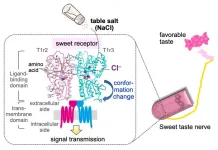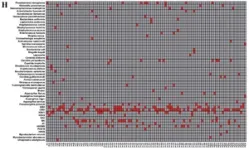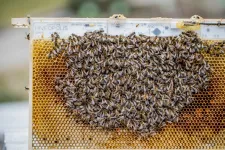(Press-News.org)
Humans perceive five basic taste sensations: sweet, umami, bitter, salty, and sour. Specific foods trigger taste recognition of these sensations through the activation of different receptors in our taste buds. In the case for table salt, the concentration is also an important factor in determining taste. For instance, the preferable concentration of table salt is 100 mM, at which humans perceive a salty taste. However, higher concentrations of salt, over 500 mM, may be perceived as bitter and/or sour, while very low concentrations, below 10 mM, are perceived as sweet by humans. Scientific studies have proposed the presence of multiple salt detection pathways in the taste buds, but their exact mechanism is not fully understood.
In the case of common salt (NaCl), salt taste sensation is primarily driven by the sodium ion, Na+. However, the anion (chloride ion Cl-) is also considered to be detected through unique molecular mechanisms and participate in the taste sensation. To investigate this chloride ion detection mechanism, scientists from Okayama University in Japan have conducted a study using structural biology methods and mice models. This study was published in eLife on 28th February, 2023.
The scientists had previously analyzed the structure of a taste receptor from the Japanese rice fish (medaka fish), which is similar to the human sweet taste receptor and is also compatible for structural analysis. A part of this fish taste receptor could bind to a chloride ion. Prof. Atsuko Yamashita explains, “We had previously analyzed the structure of the T1r2a/T1r3LBD receptor from medaka fish, which led us to the unexpected finding of the Cl- binding to T1r3LBD. In this study, we examined whether Cl- binding induces a conformational change of the receptor, and we were able to confirm the induction of this change by Cl-.” The conformational change (or change in structure) in the T1r receptors was found to be similar to that induced by other taste substances, suggesting that Cl- does activate the sweet receptors on T1r2a/ T1r3LBD. Since change in shape often indicates receptor activation, the scientists further explored the chloride ion activation of the sweet taste receptors (the T1r2/T1r3 heterodimers), which respond to sugars, in this study. Prof. Yamashita explains “We wanted to further investigate this phenomenon using better established animal models. Since the Cl--binding site in T1r3 was conserved across various species, we decided to use taste nerve recordings from mice to explore the physiological significance of Cl-.”
To provide evidence for this, they performed electrophysiological assays on mice, where they could demonstrate the activation of neurons involved in signaling of sweet taste when small amounts of chloride were placed on the mice’s tongues. Thus, they demonstrated that low concentrations of Cl- could potentially produce a ‘light’ sweet taste sensation via the T1r in the taste buds. “The Cl--induced taste is similar to that induced by canonical taste substances for T1rs, such as amino acids or sugars, though its efficacy is slightly lower.” says Prof. Yamashita. Further, when offered a choice between dilute chloride solution and plain water, the mice recognized the taste of chloride solution and demonstrated a preference for it. The concentration of sodium chloride for inducing a sweet response was found to be minute, even less than 10 mM, and this sweet sensation could be suppressed by the external application of sweet taste inhibitors containing gurmarin. These findings support the hypothesis that mice identify chloride as sweet via the action of specific receptors and neurons. They also show that dilute table salt provides a taste stimulus due to the presence of the Cl- ions.
Table salt is an important component in maintaining homeostasis or internal body equilibrium. This equilibrium is regulated by the optimum intake and excretion of sodium. This study shows that the former process uses the counter Cl- ion to regulate the molecular functions of the receptors involved. The results of this study will pave way for a more nuanced understanding of taste perception in organisms.
About Okayama University, Japan
As one of the leading universities in Japan, Okayama University aims to create and establish a new paradigm for the sustainable development of the world. Okayama University offers a wide range of academic fields, which become the basis of the integrated graduate schools. This not only allows us to conduct the most advanced and up-to-date research, but also provides an enriching educational experience.
Website: https://www.okayama-u.ac.jp/index_e.html
About Professor Atsuko Yamashita from Okayama University, Japan
Professor Atsuko Yamashita is associated with the Faculty of Medicine, Dentistry and Pharmaceutical Sciences at Okayama University in Japan. She has 64 publications related to the fields of protein structures, protein functions, and taste receptors. She has worked extensively towards research in the fields of life sciences.
END
The research published in the Journal of Infection investigated the use of metagenomic next-generation sequencing (mNGS) in diagnosing bloodstream infections (BSIs) for immunocompromised hematology patients. Hematology patients are highly susceptible to BSIs, which can have severe consequences such as septic shock, multiple-organ failure, disseminated intravascular coagulation, and even death. An accurate and quick microbiological diagnosis of BSI is therefore essential for the control of the infection.
In the study, conducted ...
March 23, 2023 – Despite the broad diversity of the U.S. population, dietary recommendations often overlook the positive contributions of cultural foods to build healthy dietary patterns. This is especially true when it comes to carbohydrate food guidance, where prevailing approaches have historically focused on only three components— carbohydrates, sugar, and dietary fiber—ignoring other important nutrient and cultural considerations. However, a new paper published in Nutrients highlights a more holistic approach, called the Carbohydrate Food Quality ...
Honeybees are famously finicky when it comes to being studied. Research instruments and conditions and even unfamiliar smells can disrupt a colony’s behavior. Now, a joint research team from the Mobile Robotic Systems Group in EPFL’s School of Engineering and School of Computer and Communication Sciences and the Hiveopolis project at Austria’s University of Graz have developed a robotic system that can be unobtrusively built into the frame of a standard honeybee hive.
Composed of an array of thermal sensors and actuators, the system measures and modulates honeybee behavior through ...
PARAMUS, N.J. (March 23, 2023) – Octapharma USA has provided a grant for an educational program on pediatric acute-onset neuropsychiatric syndrome (PANS) and PANDAS, a subset of PANS associated with strep, to be held during the National Home Infusion Association (NHIA) Annual Conference scheduled for March 25 – 27 in Washington, D.C.
Octapharma is enrolling more patients and sites for its phase 3 multicenter superiority study comparing the effectiveness of panzyga® (immune globulin intravenous, human - ifas) 10% liquid preparation versus placebo ...
Continued warming of the climate would see a rise in the number and spread of potentially fatal infections caused by bacteria found along parts of the coast of the United States.
Vibrio vulnificus bacteria grow in warm shallow coastal waters and can infect a cut or insect bite during contact with seawater. A new study led by the UK’s University of East Anglia (UEA) shows that the number of V. vulnificus infections along the East Coast of the US, a global hotspot for such infections, has gone ...
(SAN ANTONIO) MARCH 23, 2023 - Guenevere Chen, an associate professor in the UTSA Department of Electrical and Computer Engineering, recently published a paper on USENIX Security 2023 that demonstrates a novel inaudible voice trojan attack to exploit vulnerabilities of smart device microphones and voice assistants — like Siri, Google Assistant, Alexa or Amazon’s Echo and Microsoft Cortana — and provide defense mechanisms for users.
The researchers developed Near-Ultrasound Inaudible Trojan, or NUIT (French for “nighttime”) to study how hackers exploit speakers and ...
UC Riverside scientists have significantly advanced the race to control plant responses to temperature on a rapidly warming planet. Key to this breakthrough is miRNA, a molecule nearly 200,000 times smaller than the width of a human hair.
With moderate increases in temperature, plants grow taller to avoid hotter ground and get fresher air. A landmark study published in the journal Nature Communications demonstrates that microRNA or miRNA is required for this growth. The study also identifies which miRNA molecules — out of more than 100 possibilities — are the essential ones.
“We found that without miRNA plants will not grow, even ...
Medical sleep treatment may reduce self-harm in young people with anxiety and depression, an observational study from Karolinska Institutet in Sweden suggests. The risk of self-harm increased in the months preceding melatonin prescription and decreased thereafter, especially in girls. The study is published in The Journal of Child Psychology and Psychiatry.
Melatonin is a hormone that controls the sleep-wake cycle and is the most commonly prescribed drug for sleep disturbances in children and adolescents in Sweden. Melatonin use has dramatically increased in recent years, and it is available over the counter in Sweden since 2020.
“Given the established link between sleep ...
Applying hydrostatic pressure as an external stimulus, Tokyo Tech and Keio University researchers demonstrate a new way to regulate singlet fission (SF), a process in which two electrons are generated from a single photon, in chromophores, opening doors to the design of SF-based materials with enhanced (photo)energy conversion. Their method overrides the strict requirements that limit the molecular design of such materials by realizing an alternative control strategy.
Singlet fission (SF) is a process in which ...
Researchers at Chalmers University of Technology, Sweden, have developed a new method that can easily purify contaminated water using a cellulose-based material. This discovery could have implications for countries with poor water treatment technologies and combat the widespread problem of toxic dye discharge from the textile industry.
Clean water is a prerequisite for our health and living environment, but far from a given for everyone. According to the World Health Organization, WHO, there are currently over two billion people living with limited or no access to clean water.
This global challenge ...







